28.4: Superphylum Ecdysozoa
- Page ID
- 203225
培养技能
- 描述线虫的结构组织
- 了解 Caenorhabditis Elegans 在研究中的重要性
- 比较 phylum Arthropoda 的内部系统和附属物专业化
- 讨论节肢动物的环境重要性
- 讨论节肢动物成功和丰富的原因
superphylum Ecdysozoa 包含大量物种。 这是因为它包含两个最多样化的动物群体:phylum Nematoda(蚯蚓)和 Phylum Arthropoda(节肢动物)。 Ecdysozoans 最突出的显著特征是它们坚硬的外部覆盖物,称为角质层。 角质层提供了坚韧但灵活的外骨骼,可以保护这些动物免受水分流失、捕食者和外部环境其他方面的影响。 这个 superphylum 的所有成员都会在成长过程中定期褪色或脱落角质层。 变质后,它们会分泌出一个新的角质层,该角质层将持续到下一个生长阶段。 变质和替换角质层的过程被称为腐烂,这就是 superphylum 得名的方式。
Phylum Nematoda
像大多数其他动物门一样,线虫是三倍体,其胚胎中胚层夹在外胚层和内胚层之间。 它们也是双边对称的,这意味着纵向截面将它们分为对称的左右两侧。 此外,线虫或蚯蚓,具有伪腔体,由自由生活和寄生形式组成。
有人说,如果生物圈中的所有非线虫物质都被清除,前世界的阴影将以线虫的形式存在。 1 节肢动物是地球上最成功的分类组之一,是以坚硬的外骨骼和关节附属物为特征的 coelomate 生物。 线虫和节肢动物都属于 superphylum Ecdysozoa,它被认为是一个由来自一个共同祖先的所有进化后代组成的进化枝。 这个名字源自 ecdysis 这个词,它指的是外骨骼的脱落或蛀牙。 该组中的门有坚硬的角质层可以遮住他们的身体,必须定期脱落并更换角质层才能增大。
Phylum Nematoda 包括 28,000 多种物种,估计有 16,000 种在自然界中是寄生物。 Nematoda 这个名字源自希腊语 “Nemos”,意思是 “线”,包括蚯蚓。 线虫存在于所有栖息地中,每个栖息地中都存在每种物种的大量个体。 自由生活的线虫 Caenorhabditis Elegans 已被广泛用作世界各地实验室的模型系统。
形态学
与刺胞动物形成鲜明对比的是,线虫呈管状形态和圆形横截面。 这些动物是 pseudocoelomates,表现出完整的消化系统,口腔和肛门都很明显。 这与刺胞动物形成鲜明对比,后者只有一个开口(消化系统不完整)。
线虫的角质层富含胶原蛋白和一种叫做甲壳素的碳水化合物蛋白质聚合物,并在表皮之外形成外部 “骨架”。 角质层还在内部排列着许多器官,包括咽部和直肠。 表皮可以是单层细胞,也可以是合胞细胞,后者是由未核细胞融合形成的多核细胞。
这些蠕虫的整体形态是圆柱形的,如图所示\(\PageIndex{1}\)。 头部径向对称。 前端有三到六个嘴唇的开口,在某些物种中,牙齿以角质层延伸的形式出现。 有些线虫可能会出现其他外部修饰,例如戒指、头罩或疣。 但是,戒指并不能反映真实的身体内部分割。 口腔通向肌肉发达的咽部和肠道,这会导致后端的直肠和肛门开口。 线虫的肌肉与大多数动物的肌肉不同:它们只有纵向层,这解释了它们运动的鞭子般的运动。
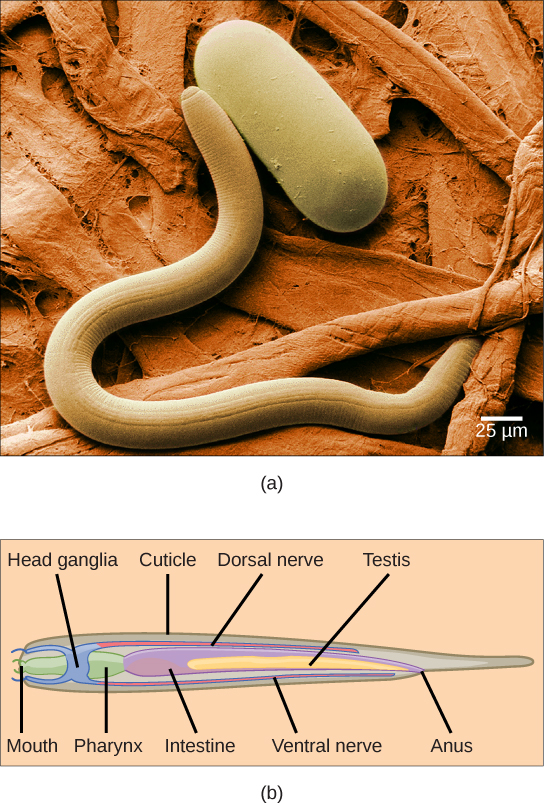
排泄系统
在线虫中,专门的排泄系统尚未发达。 含氮废物可能会通过扩散到全身或进入假体腔(体腔)而流失,然后由专门的细胞清除。 人体水和盐含量的调节是通过海洋线虫咽下存在的 renette 腺来实现的。
神经系统
大多数线虫都有四根纵向神经绳,它们沿着身体的背部、腹侧和侧向位置延伸。 腹侧神经绳比背绳或外侧神经绳发育得更好。 所有神经线在前端、咽部周围融合形成头神经节或 “大脑”(在咽部周围呈环状),在后端融合形成尾神经节。 在 C 中。 线虫,神经系统占动物细胞总数的近三分之一。
繁殖
线虫采用各种繁殖策略,从雌雄异株到雌雄异株再到单性生殖不等,具体取决于所考虑的物种。 C。 线虫是一种雌雄异株物种,显示子宫中所含卵子以及精子中所含精子的发育。 子宫有一个称为外阴的外部开口。 女性生殖器毛孔位于身体中部附近,而雄性的毛孔位于身体尖端。 雄性尾巴的特殊结构使他保持原位,同时他用交配尖刺沉积精子。 受精是内部的,胚胎发育在受精后不久就开始了。 胚胎在胃化阶段从外阴释放出来。 胚胎发育阶段持续 14 个小时;然后发育持续到连续的四个幼虫阶段,每个阶段(L1、L2、L3 和 L4)之间会出现腐烂,最终导致幼雄性或雌性成年蠕虫的发育。 人满为患和缺乏食物等不利的环境条件可能导致形成被称为 dauer larva 的中间幼虫阶段。
Everyday Conn ection:将发育研究与遗传学联系起来的模型系统
如果生物学家想研究体内尼古丁依赖是如何发展的,脂质是如何调节的,或者观察某些气味的引诱剂或驱虫剂特性,他们显然需要设计三个截然不同的实验。 但是,他们可能只需要一个研究对象:线虫。 悉尼·布伦纳博士将线虫 Caenorhabditis Elegans 列为主流生物学研究的焦点。 自1963年以来,布伦纳博士和世界各地的科学家一直使用这种动物作为模型系统来研究各种生理和发育机制。
线虫是一种存在于土壤中的自由生活生物。 在琼脂板(10,000个蠕虫/盘)上培养这种生物很容易,它以大肠杆菌(全球生物实验室的另一个长期居民)为食,因此,它很容易在实验室中生长和维护。 这种线虫的最大资产是它的透明度,它可以帮助研究人员轻松观察和监测动物体内的变化。 它也是一种简单的生物体,有少于1,000个细胞和20,000个基因的基因组。 它显示了DNA的染色体组织,分为五对常染色体和一对性染色体,使其成为研究遗传学的理想候选人。 由于每个细胞都可以被可视化和识别,因此该生物可用于研究细胞间的相互作用、细胞命运测定、细胞分裂、细胞凋亡和细胞内转运等细胞现象。
另一个巨大资产是这种蠕虫的生命周期短(图\(\PageIndex{2}\))。 实现 “卵到成虫卵到子卵” 只需要3天;因此,追踪这种动物的遗传变化比较容易。 线虫的总寿命为2至3周;因此,很容易观察到与年龄相关的现象。 使线虫成为优秀实验模型系统的另一个特征是,该生物的成体雌雄同体中存在的959个细胞的位置和数量是恒定的。 在研究细胞分化、细胞间通信和细胞凋亡时,这一特征极为重要。 最后,线虫也适合使用分子方法进行基因操纵,这使其作为模型系统的用处更加完善。
世界各地的生物学家创建了专门研究线虫的信息库和小组。 例如,他们的发现使人们更好地了解了发育过程中的细胞交流、神经元信号传导以及对脂质调节(这对于解决肥胖和糖尿病发展等健康问题很重要)的洞察力。 近年来,研究启发了医学界,使他们对多囊肾病有了更好的了解。 这种简单的生物使生物学家得出了复杂而重要的发现,以触及日常世界的方式发展了科学领域。
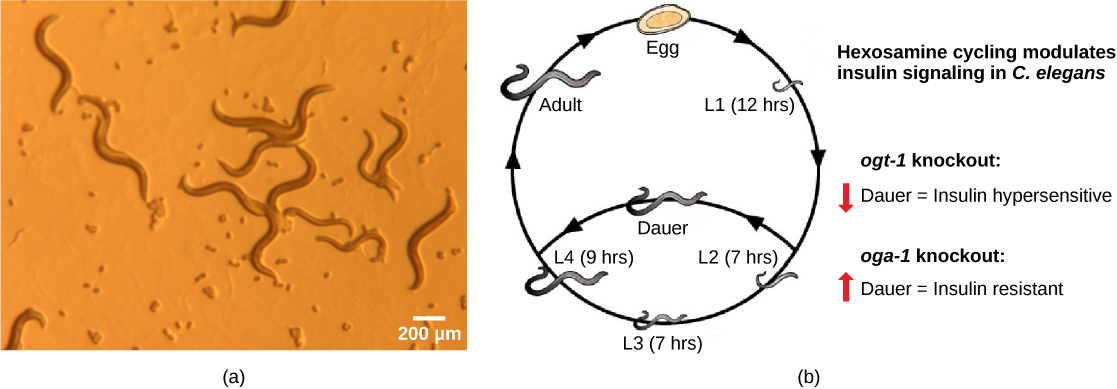
许多常见的寄生线虫就是寄生虫的典型例子。 这些动物表现出复杂的生命周期,涉及多个宿主,它们可能对医学和兽医产生重大影响。 当人类饮用含有桡足类的未经过滤的水时,他们可能会被称为几内亚蠕虫的麦地那龙线虫感染(图\(\PageIndex{3}\))。 钩虫,例如 Ancyclostom a和 Necator,会侵扰肠道并以哺乳动物的血液为食,尤其是在狗、猫和人类中。 旋毛虫(Trichinella)是人类旋毛虫病的病原体,通常是由食用未煮熟的猪肉引起的;旋毛虫也可以感染其他哺乳动物宿主。 Ascaris 是一种大肠蚯蚓,它会从人体宿主那里窃取营养,并可能对肠道造成物理阻塞。 丝虫蠕虫,例如 Dirofilaria 和 Wuchereria,通常由蚊子传播,蚊子通过吸血活动在哺乳动物中传染病原体。 Dirofilaria immitis 是一种血液感染寄生虫,是臭名昭著的狗心丝虫物种。 Wuchereria bancrofti 感染人类的淋巴结,导致一种称为象皮病的非致命但变形的疾病,在这种疾病中,由于淋巴引流阻塞和淋巴组织发炎,身体的各个部位肿胀到很大的比例。
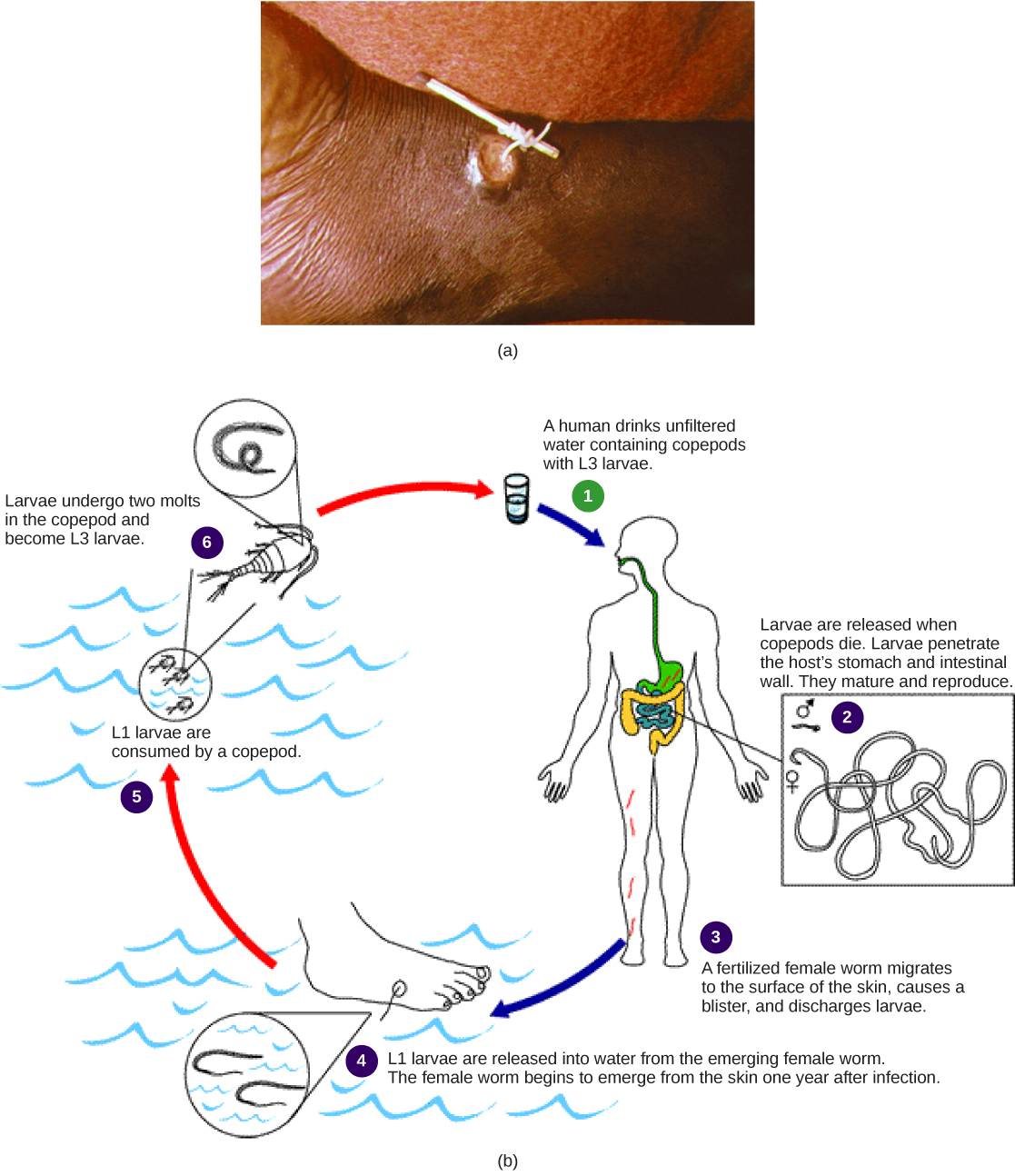
Phylum Arthropoda
“arthropoda” 这个名字的意思是 “关节腿”(在希腊语中,“arthros” 的意思是 “关节”,“podos” 的意思是 “腿”);它恰当地描述了这个 phylum 中包含的大量无脊椎动物。 Arthropoda 在动物界占据主导地位,估计有85%的已知物种包含在此 phylum 中,还有许多节肢动物尚未记录在案。 这个 phylum 中所有动物的主要特征是身体的功能分裂和关节附属物的存在。 节肢动物还显示存在主要由甲壳素制成的外骨骼,甲壳素是一种防水、坚韧的多糖。 Phylum Arthropoda 是动物世界中最大的 phylum,昆虫是这个 phylum 中最大的单一类别。 节肢动物是 eucoelomate,原生生物。
Phylum Arthropoda 包括成功殖民陆地、水生和空中栖息地的动物。 这个 phylum 进一步分为五个 subphyla:Trilobitomorpha(三叶虫,全部灭绝)、Hexapoda(昆虫和亲属)、Myriapoda(千足动物、Centipedes 和亲属)、甲壳类动物(螃蟹、龙虾、小龙虾、藤壶和一些浮游动物)和 Chelicerata(horicerata)seshoe crabs、arachnids、蝎子和爸爸长腿)。 三叶虫是一组已灭绝的节肢动物,主要存在于前寒武纪时代,可能与Chelicerata关系最为密切。 这些是根据化石记录识别出来的(图\(\PageIndex{4}\))。
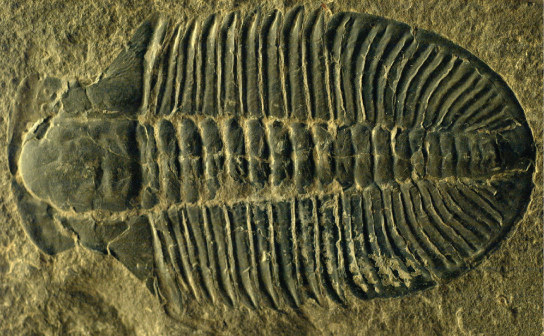
形态学
节肢动物 phylum 中动物的一个独特特征是存在分段的身体和一系列片段的融合,这些片段会产生称为 tagma 的功能性身体区域。 Tagma 可能是头部、胸部和腹部,或者是头胸和腹部,或者是头部和躯干。 存在一个叫做 h emocoel(或血腔)的中心腔,开放的循环系统由管状或单腔心脏调节。 呼吸系统因节肢动物的群体而异:昆虫和无数足类动物使用一系列管子(气管),这些管子在人体中分支,通过称为螺旋的开口向外开放,直接在细胞和气管中的空气之间进行气体交换,而水生甲壳类动物则使用、陆生螯合物使用书肺,水生螯合物使用书(图\(\PageIndex{5}\))。 《蜘蛛之肺》(蝎子、蜘蛛、壁虱和螨虫)这本书包含一堆垂直的 hemocoel 壁组织,有点像书页。 每张 “纸巾” 之间都有一个空域。 这允许组织的两侧随时与空气接触,从而极大地提高了气体交换的效率。 甲壳类动物的鳃是丝状结构,可与周围的水交换气体。 节肢动物的排泄器官也有所不同,甲壳类动物拥有绿色腺体,昆虫使用马尔皮吉亚小管,后者与后肠一起重新吸收水分,同时清除体内的含氮废物。 角质层是节肢动物的覆盖物。 它由两层组成:epicuticle,它是一种不含甲壳素的薄蜡质防水外层,其下层是几丁质产品。 甲壳素是一种坚韧而灵活的多糖。 为了生长,节肢动物必须在称为腐蚀的过程中脱落外骨骼(“脱掉”);这是一种繁琐的生长方法,在此期间,动物很容易受到捕食。 下文描述了来自每个 subphylum 的代表性动物的特征形态。
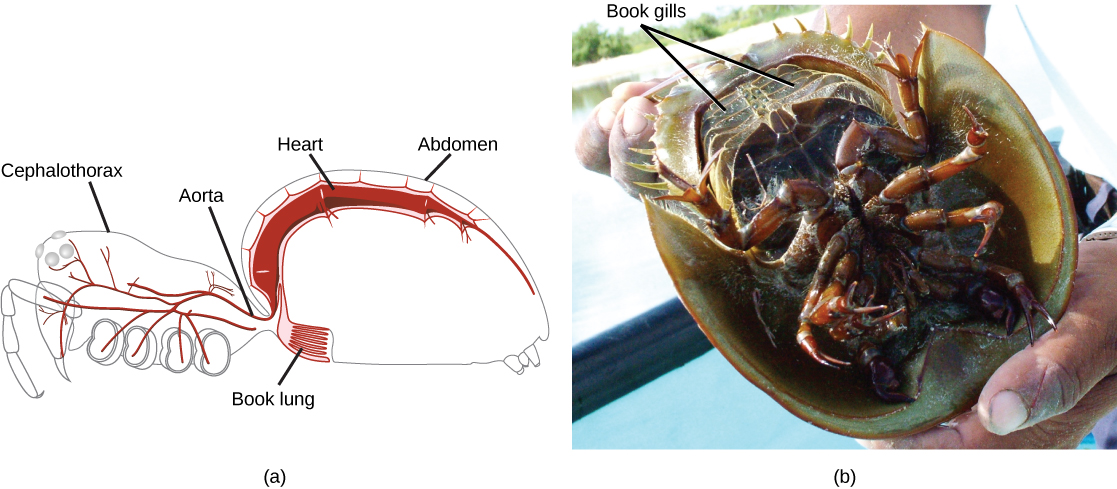
Subphylum Hexapoda
Hexapoda这个名字表示这些动物中有六条腿(三对),这与其他节肢动物中存在的双腿数量不同。 六足动物的特征是存在头部、胸部和腹部,构成三个 tagma。 胸部有翅膀和六条腿,分为三对。 我们每天遇到的许多常见昆虫,包括蚂蚁、蟑螂、蝴蝶和苍蝇,都是六足动物的例子。
在六足动物中,昆虫(图\(\PageIndex{6}\))在物种多样性和陆地栖息地生物量方面是最大的类别。 通常,头部有一对感官触角,下颌骨作为口器,一双复眼,一些 ocelli(简单的眼睛)以及许多感官毛发。 胸部有三对腿(每段一对)和两对翅膀,第二和第三胸段各有一对翅膀。 腹部通常有十一个段,有生殖孔。 Hexapoda 包括有翅的昆虫(如果蝇)和没有翅膀的昆虫(如跳蚤)。
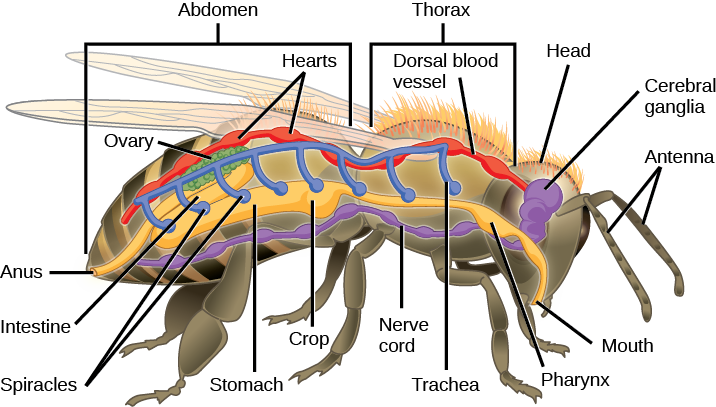
练习\(\PageIndex{1}\)
以下关于昆虫的陈述中哪一项是错误的?
- 昆虫有背侧和腹侧血管。
- 昆虫有螺旋形开口,允许空气进入。
- 气管是消化系统的一部分。
- 昆虫的消化系统发达,有口腔、作物和肠道。
- 回答
-
c
Subphylum Myriapoda
Subphylum Myriapoda 包括有许多腿的节肢动物。 尽管这个名字有点夸张,暗示这些无脊椎动物中有无数的腿,但腿的数量可能从10到750不等。 这个 subphylum 包括 13,000 个物种;最常见的例子是千足虫和萜类。 所有 myriapods 都是陆生动物,更喜欢潮湿的环境。
Myriapods 通常存在于潮湿的土壤、腐烂的生物物质和树叶垃圾中。 Subphylum Myriapoda 分为四类:Chilopoda、Symphyla、Diplopoda 和 Pauropoda。 像 Scutigera coleoptrata 这样的蚯蚓(图 28.4.7)被归类为 chilopods。 这些动物每节有一对腿,下颌骨作为口器,背腹部有些扁平。 第一段中的腿部经过改造后形成了 forcipules(毒爪),向蜘蛛和蟑螂等猎物输送毒药,因为这些动物都是掠食性的。 千足虫每个 diplosegment 有两对腿,这种特征是由相邻成对的身体段的胚胎融合产生的,横截面通常更圆,是食草动物或破坏动物。 千足虫的腿数明显多于蚯蚓,尽管它们没有一千条腿(图\(\PageIndex{7}\))。
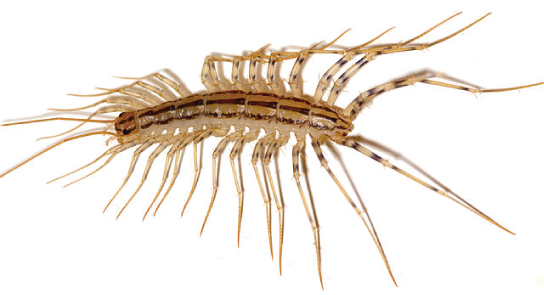
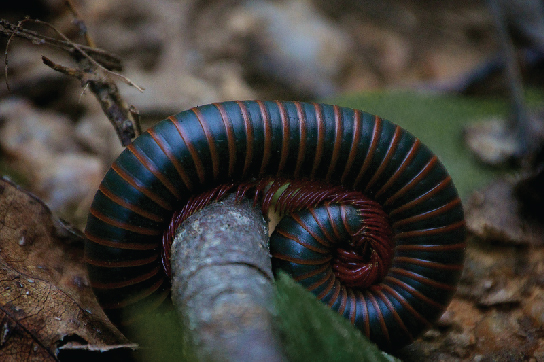
Subphylum Crustacea
Crustaceans are the most dominant aquatic arthropods, since the total number of marine crustacean species stands at 67,000, but there are also freshwater and terrestrial crustacean species. Krill, shrimp, lobsters, crabs, and crayfish are examples of crustaceans (Figure \(\PageIndex{8}\)). Terrestrial species like the wood lice (Armadillidium spp.) (also called pill bugs, rolly pollies, potato bugs, or isopods) are also crustaceans, although the number of non-aquatic species in this subphylum is relatively low.
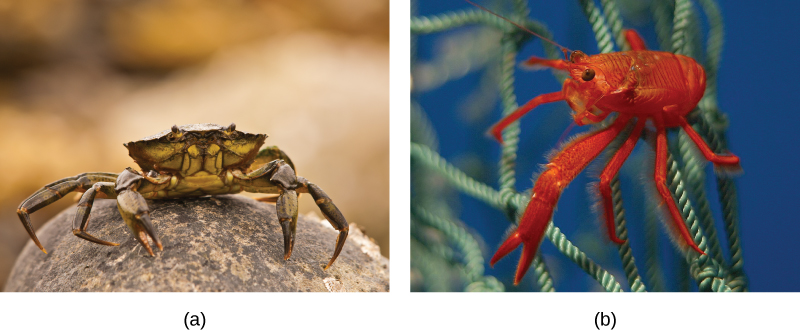
Crustaceans possess two pairs of antennae, mandibles as mouthparts, and biramous (“two branched”) appendages, which means that their legs are formed in two parts, as distinct from the uniramous (“one branched”) myriapods and hexapods (Figure \(\PageIndex{9}\)).
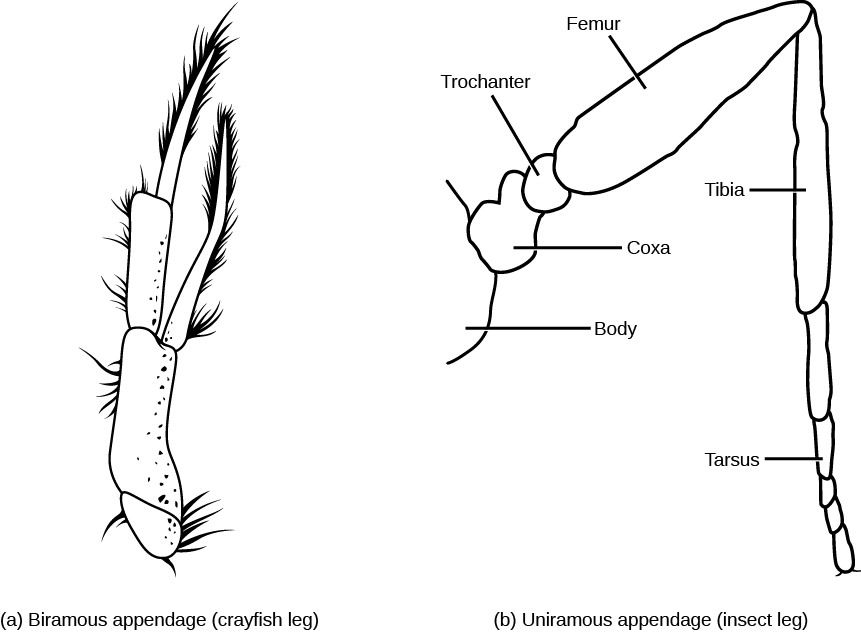
Unlike that of the Hexapoda, the head and thorax of most crustaceans is fused to form a cephalothorax (Figure \(\PageIndex{10}\)), which is covered by a plate called the carapace, thus producing a body structure of two tagma. Crustaceans have a chitinous exoskeleton that is shed by molting whenever the animal increases in size. The exoskeletons of many species are also infused with calcium carbonate, which makes them even stronger than in other arthropods. Crustaceans have an open circulatory system where blood is pumped into the hemocoel by the dorsally located heart. Hemocyanin and hemoglobin are the respiratory pigments present in these animals.

Most crustaceans are dioecious, which means that the sexes are separate. Some species like barnacles may be hermaphrodites. Serial hermaphroditism, where the gonad can switch from producing sperm to ova, may also be seen in some species. Fertilized eggs may be held within the female of the species or may be released in the water. Terrestrial crustaceans seek out damp spaces in their habitats to lay eggs.
Larval stages—nauplius and zoea—are seen in the early development of crustaceans. A cypris larva is also seen in the early development of barnacles (Figure \(\PageIndex{11}\)).
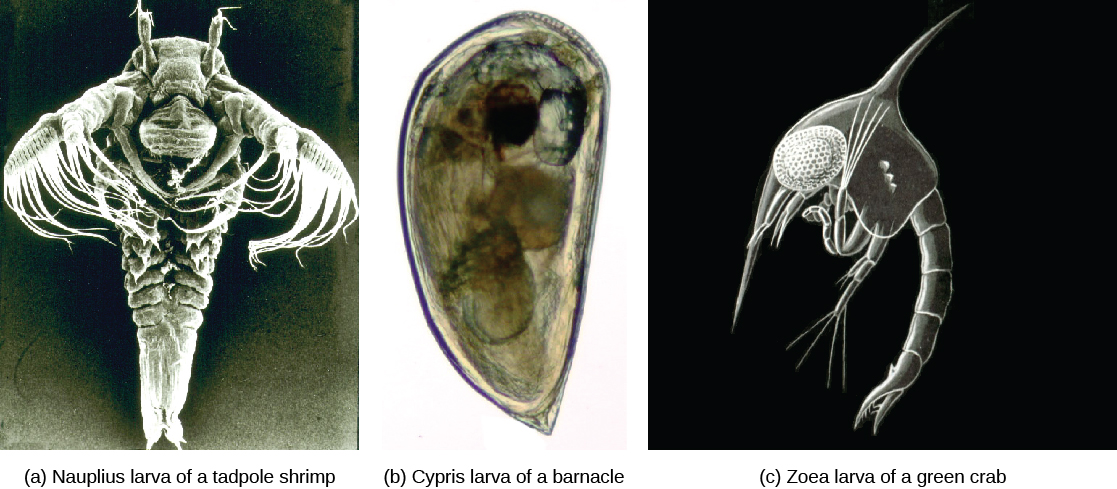
Crustaceans possess a tripartite brain and two compound eyes. Most crustaceans are carnivorous, but herbivorous and detritivorous species are also known. Crustaceans may also be cannibalistic when extremely high populations of these organisms are present.
Subphylum Chelicerata
This subphylum includes animals such as spiders, scorpions, horseshoe crabs, and sea spiders. This subphylum is predominantly terrestrial, although some marine species also exist. An estimated 77,000 species are included in subphylum Chelicerata. Chelicerates are found in almost all habitats.
The body of chelicerates may be divided into two parts: prosoma and opisthosoma, which are basically the equivalents of cephalothorax (usually smaller) and abdomen (usually larger). A “head” tagmum is not usually discernible. The phylum derives its name from the first pair of appendages: the chelicerae (Figure \(\PageIndex{12}\)), which are specialized, claw-like or fang-like mouthparts. These animals do not possess antennae. The second pair of appendages is known as pedipalps. In some species, like sea spiders, an additional pair of appendages, called ovigers, is present between the chelicerae and pedipalps.
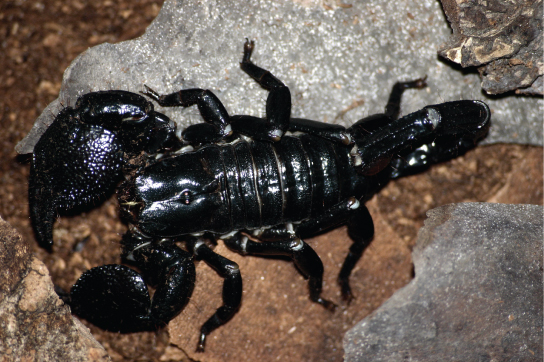
Chelicerae are mostly used for feeding, but in spiders, these are often modified into fangs that inject venom into their prey before feeding (Figure \(\PageIndex{13}\)). Members of this subphylum have an open circulatory system with a heart that pumps blood into the hemocoel. Aquatic species have gills, whereas terrestrial species have either trachea or book lungs for gaseous exchange.
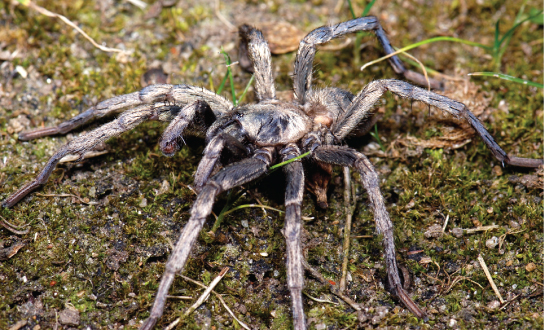
Most chelicerates ingest food using a preoral cavity formed by the chelicerae and pedipalps. Some chelicerates may secrete digestive enzymes to pre-digest food before ingesting it. Parasitic chelicerates like ticks and mites have evolved blood-sucking apparatuses.
The nervous system in chelicerates consists of a brain and two ventral nerve cords. These animals use external fertilization as well as internal fertilization strategies for reproduction, depending upon the species and its habitat. Parental care for the young ranges from absolutely none to relatively prolonged care.
Summary
Nematodes are pseudocoelomate animals akin to flatworms, yet display more advanced neuronal development, a complete digestive system, and a body cavity. This phylum includes free-living as well as parasitic organisms like Caenorhabditis elegans and Ascaris spp., respectively. They include dioeceous as well as hermaphroditic species. Nematodes also possess an excretory system that is not quite well developed. Embryonic development is external and proceeds via three larval stages. A peculiar feature of nematodes is the secretion of a collagenous/chitinous cuticle outside the body.
Arthropods represent the most successful phylum of animal on Earth, in terms of the number of species as well as the number of individuals. These animals are characterized by a segmented body as well as the presence of jointed appendages. In the basic body plan, a pair of appendages is present per body segment. Within the phylum, traditional classification is based on mouthparts, number of appendages, and modifications of appendages present. Arthropods bear a chitinous exoskeleton. Gills, trachea, and book lungs facilitate respiration. Sexual dimorphism is seen in this phylum, and embryonic development includes multiple larval stages.
Footnotes
- 1 Stoll, N. R., “This wormy world. 1947,” Journal of Parasitology 85(3) (1999): 392-396.
Glossary
- Arthropoda
- phylum of animals with jointed appendages
- biramous
- referring to two branches per appendage
- cephalothorax
- fused head and thorax in some species
- chelicera
- modified first pair of appendages in subphylum Chelicerata
- cuticle (animal)
- the tough, external layer possessed by members of the invertebrate class Ecdysozoa that is periodically molted and replaced
- cypris
- larval stage in the early development of crustaceans
- hemocoel
- internal body cavity seen in arthropods
- hermaphrodite
- referring to an animal where both male and female gonads are present in the same individual
- nauplius
- larval stage in the early development of crustaceans
- Nematoda
- phylum of worm-like animals that are triploblastic, pseudocoelomates that can be free-living or parasitic
- oviger
- additional pair of appendages present on some arthropods between the chelicerae and pedipalps
- pedipalp
- second pair of appendages in Chelicerata
- uniramous
- referring to one branch per appendage
- zoea
- larval stage in the early development of crustaceans


